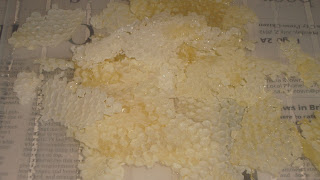Honey Day
Finally got a wonderful break in the weather, with temps only in the upper 70's and DRY (the humidity, here--we still could use some rain though we got just under an inch when the cold front noisily passed through, taking out a number of trees and limbs in the area.)
As I indicated earlier, we knew we were going to have a good honey season, with all the white clover this year. I'll go through the process the way we do it.
We work in our "barn", where we can keep the bees out and have plenty of room to make a mess if need be. Here we have a bowl of water, our uncapping tray, the 5 gallon filtering pail beyond and then the old A.I. Root Extractor in the background.
Here are a few of the nice frames of honey we have this year. Today we extracted 19 frames. Here you see Kathy uncapping the frame with an electric knife. She likes to use that--I can't handle it. Give me a long, serrated bread knife anytime. We don't have a heated uncapping knife. We feel we can do what we have with what we have pretty effectively. Perhaps if we had a bigger job to do we'd invest in a heated knife. Maybe not. Note the unorthodox pick we use for those stray cells that don't get opened from the knife. It's an old ice pick but works great.
Here are some of the cappings. After we squeeze all the possible honey out, this will become some nice beeswax to go in our molds.
After Kathy removes the cappings, I put two frames in the extractor. It has a 4 to 1 ratio. I crank about 75 turns, flip the trays to the opposite side and crank again. It works pretty well and the frames come out in decent shape, with most of the cells pretty intact.
After extracting the honey from the frames, we pour the honey into our 5 gallon filtering pail. It has two fine filters, so only the honey flows through. No wax, bug parts or anything else. It was only about 80 degrees so it moved fairly slowly through the filters.
After going through the filters, Kathy puts the honey into half-gallon jars, to be split into smaller containers later after bubbles have all risen and the honey clears. It seems slightly darker this year compared with last, but still as sweet.
Over 5 and a half gallons. Not too shabby for a drought year I'd say.
As I indicated earlier, we knew we were going to have a good honey season, with all the white clover this year. I'll go through the process the way we do it.
We work in our "barn", where we can keep the bees out and have plenty of room to make a mess if need be. Here we have a bowl of water, our uncapping tray, the 5 gallon filtering pail beyond and then the old A.I. Root Extractor in the background.
Here are a few of the nice frames of honey we have this year. Today we extracted 19 frames. Here you see Kathy uncapping the frame with an electric knife. She likes to use that--I can't handle it. Give me a long, serrated bread knife anytime. We don't have a heated uncapping knife. We feel we can do what we have with what we have pretty effectively. Perhaps if we had a bigger job to do we'd invest in a heated knife. Maybe not. Note the unorthodox pick we use for those stray cells that don't get opened from the knife. It's an old ice pick but works great.
Here are some of the cappings. After we squeeze all the possible honey out, this will become some nice beeswax to go in our molds.
After Kathy removes the cappings, I put two frames in the extractor. It has a 4 to 1 ratio. I crank about 75 turns, flip the trays to the opposite side and crank again. It works pretty well and the frames come out in decent shape, with most of the cells pretty intact.
 | |||||||||
| Looking down inside the extractor. A cage on each side holds a frame. |
After extracting the honey from the frames, we pour the honey into our 5 gallon filtering pail. It has two fine filters, so only the honey flows through. No wax, bug parts or anything else. It was only about 80 degrees so it moved fairly slowly through the filters.
After going through the filters, Kathy puts the honey into half-gallon jars, to be split into smaller containers later after bubbles have all risen and the honey clears. It seems slightly darker this year compared with last, but still as sweet.
Over 5 and a half gallons. Not too shabby for a drought year I'd say.












Jim,
ReplyDeleteFinally seeing and tasting the honey makes it all worth while doesn't it. That is one big extractor too. I just the other day bottled up and labeled 24 jars of honey here, my first labels, home made of course.
Yes, Randy, I agree, it is great to get your own honey. My favorite part, aside from tasting, is seeing that pure, golden honey flow through the spigot into the jars and just reflecting on how incredible it is that this was all produced by those little insects. After all the honey filtered out, we actually ended up with over six gallons, double our production from last year. We may get more, as the bees are now all over the large patch of buckwheat Kathy planted and goldenrod is in bloom.
ReplyDeleteWow Jim! That is a whole lotta honey! Awesome season for you! So happy to read your hives are doing well and being very productive.
ReplyDelete